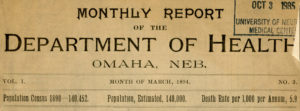By John Schleicher
Omaha was founded in 1854, as soon as Nebraska Territory opened to settlement. It was formally incorporated as a city on February 2, 1857, and was the territorial capital. In 1855, the first physician in the city, Dr. George Miller, “busied himself in public city health matters.” One of the first few ordinances passed by the new city government dealt with a public health issue—the disposal of dead animal carcasses that lay in the often very mud dy streets. Over the ensuing years, city leaders continued to concern themselves with public health out of necessity.
dy streets. Over the ensuing years, city leaders continued to concern themselves with public health out of necessity.
The March 1894 edition of the “Monthly Report of the Department of Health, Omaha” (see image), was still reporting the number and type of dead animals removed from the streets and from public and private property, which included horses, mules, cows, dogs, cats, colts, calves, and hogs. This publication also listed communicable diseases reported in the city, including diphtheria, scarlet fever, measles, typhoid fever, diarrheal diseases, small pox, whooping cough, and puerpural sepsis.
At the granting of statehood, on March 1, 1867, the capital was removed to the new town of Lincoln, further west. The local governments of both the City of Omaha and Douglas County continued to be aware of and concerned about the health of their citizens. The library’s archives hold monthly reports of the Omaha Department of Health from March 1894 to 1903, and monthly and annual reports from 1938-1947, called the Health Bulletin, from the Omaha Bureau of Health. Later, there was a health agency known as the Omaha-Douglas County Health Department. The first Douglas County Hospital opened in 1887, and a City Emergency Hospital opened in 1912.